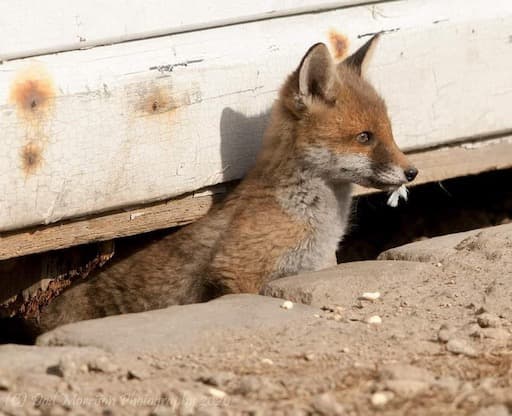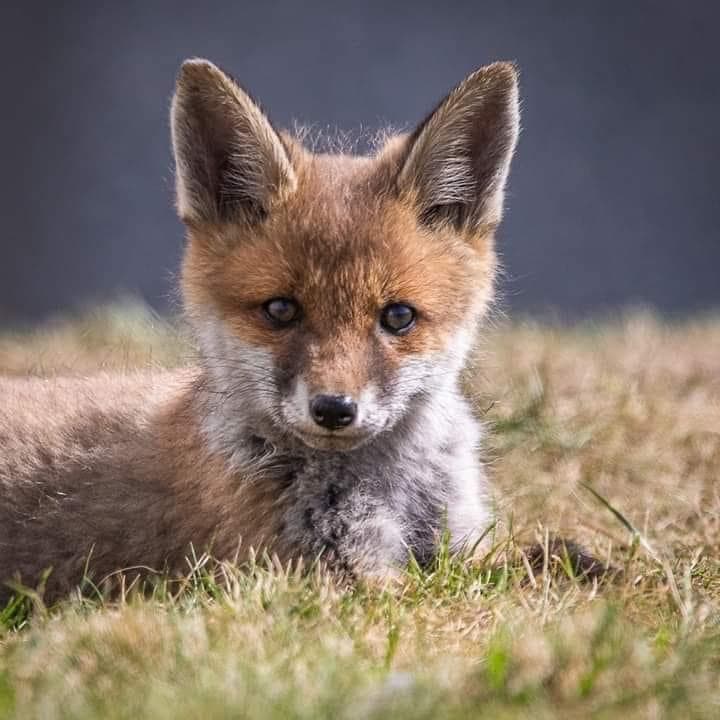Foxes In Spring
Foxes live in their territories in small family groups, with a dog fox (male) a vixen (female), their cubs, and depending on the amount of food available, 1-4 other foxes, both males and females - possibly from the previous litter. The size of the territories varies depending on the how much food is available and plant cover but generally the size is 2-3 square miles which is about the size of 968 to 1,452 football pitches!
Foxes spend much of their time on their own, foraging for food, but do come together briefly to groom and play.
Foxes only breed once per year, in January/February. The dog fox and vixen will stay together for about 3 weeks before mating.
The vixen looks for a suitable place for her den or earth. Jock knows vixens like to dig them under tree roots or in holes in dykes, or rock crevices, or they can expand holes which other animals have dug, like rabbit burrows. Urban foxes often dig their earths under garden sheds!
It takes 53 days for the foxes to be born, in March or April. The litter will usually have 4/5 cubs, which are born blind and deaf. They have round faces, short ears and dark chocolate brown fur and weigh about 120 g.
The vixen stays in the earth suckling her cubs for the first 2 weeks, and it’s the dog fox’s job to bring them food. She will suckle them for a month. At around 10-14 days old they open their eyes, their pupils are slate blue, and they grow guard hairs, making them look quite fuzzy. By now they weigh 350 g.
After about 4-5 weeks, in April or early May, the cubs begin to come out into the open. Their pupils are now grey and flecked with brown, and their round faces are changing as the muzzle starts to grow, white appears round the mouth, with patches of red on the face. Their woolly fur begins to change colour to red/brown and the ears are now upright. They will hunt minibeasts-insects and earthworms.
By 8 weeks the pupils have become amber coloured and the face has grown to adult proportions, and the woolly coat has become adult coloured.
Most of their food is provided by the adult foxes. Foxes have a really diverse diet. They are expert hunters, catching rabbits, rodents, birds, frogs and earthworms as well as eating the decaying flesh of dead animals ( carrion) . But they aren’t carnivorous - they are actually omnivores as they dine on berries and fruit too.
Finding food for 4 or 5 hungry, growing cubs is full on, and adults caring for a litter can look thin. Sometimes the other females in the group will help to feed the cubs. The cubs beg for food and nuzzle the adult’s mouth, whining ,wagging their tails, keeping their bodies low to the ground. They will fight over food, arching their backs, hackles up, heads low, and making high pitched key-kek-kekking noises. Tugging at the larger mammals the adults bring in breaks them up, so the cubs can eat them.
By around 8 weeks after lots of fights, the pecking order in the litter will have been settled. As they get older, they stand on their back legs and try to push each other over with their front legs. The loser will be pushed over and can be bitten on their tails or rumps. Dominant cubs will get more of the food and grow faster. They also are groomed more by the adults and are more likely to be allowed to stay with the group.
Around July, the cubs will begin foraging for food, slowly developing their hunting skills, and competing with the adults, who will sometimes take their kills.
Over the summer the cubs look like lanky adults with thin coats, but by late September/early October when they grow their winter coats and look like the grown ups. This is when the group starts to break up.
Discover Wildlife has fantastic information about foxes: Discover Wildlife - Fox Behaviour
You can also find out more here (and don't forget to watch the last item's video):
- Species - Fox (The Manmal Society)
- Red Fox (Young People's Trust For The Environment)
- The Fox (Woodland Trust)
- Baby Fox Bounces On A Trampoline (BBC Video)
This is part of the Animals In Spring information.

